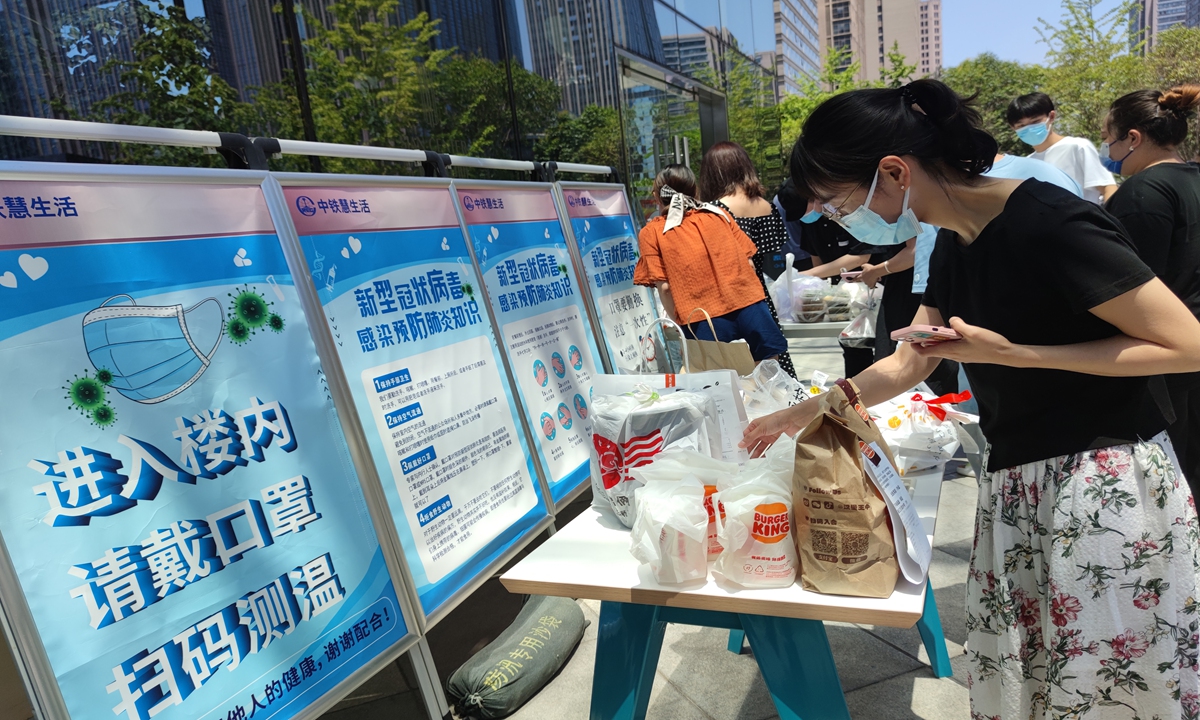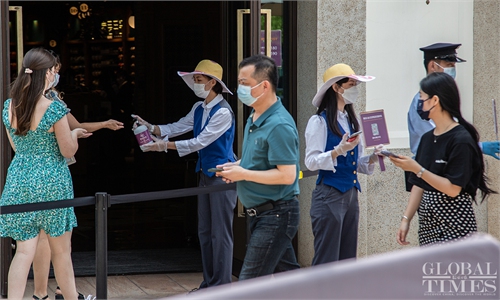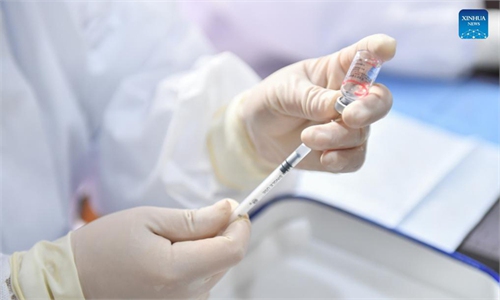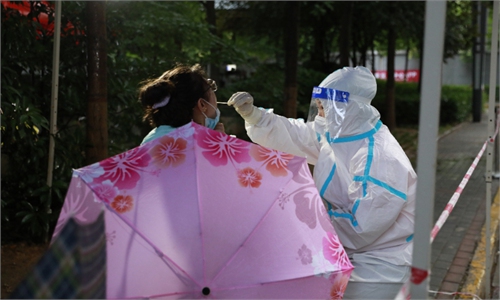Beijing, Xi’an report new infections caused by BA.5.2
Quick response stressed in sub-variant combat

Residents fetch take-out food outside an office building in Xi'an, Northwest China's Shaanxi Province, the first day that the city conducts seven-day temporary epidemic prevention control measures in some public areas. Photo: VCG
Cases caused by Omicron's sub-variant BA.5.2 have been discovered in Beijing and Northwest China's Shaanxi Province, leading to strengthened anti-epidemic measures in those areas. As the current dominant variant in the US and Europe, the sub-variant has triggered public concern among Chinese people, with experts and officials stressing that the key is to "cope with fast transmission by fast reaction."Xi'an, capital of Shaanxi, launched temporary seven-day epidemic prevention control measures in some public places on Wednesday after the city reported 29 infections in the previous four days.
Large commercial and supermarket complexes, convenience stores, farmers' markets and medical institutions closely related to people's lives are currently operating normally, according to Xi'an local authorities. Entertainment venues and dine-in services were suspended.
Xi'an also launched mass nucleic acid testing on early Wednesday. Many residents reportedly had to go outside their homes to take nucleic acid tests at midnight.
The moves in Xi'an followed the central governmental authorities' requirement to avoid one-size-fits-all and overly strict anti-epidemic policies in some places, triggering concerns among the public that it was an overreaction to less than 30 cases.
In response, the Xi'an government issued a notice on China's Twitter-like Sina Weibo on late Tuesday, stressing that the control measures in Xi'an are not aimed at locking down the city.
Ma Chaofeng, a health official in Xi'an, noted at the Tuesday press conference that the cases reported recently were caused by the BA.5.2 sub-variant and were linked to a renewable resources market. The epidemiological investigation is still underway.
The cases in Xi'an were the first infections caused by the BA.5.2 sub-variant to be reported on the Chinese mainland. In May, the mainland had reported its first case caused by BA.5, media reported.
On Wednesday, Beijing authorities also confirmed that they had discovered three infections caused by the BA.5.2 sub-variant.
Pang Xinghuo, a Beijing health official, said that the latest cases were allegedly caused by imported virus and the current situation is still under control.
Compared with the previous BA.1 and BA.2, the BA.5 variant, which is dominant in the US and Europe, spreads faster and appears to escape antibody responses among both people who had previous COVID-19 infections and those who have been fully vaccinated and boosted, according to global researchers.
BA.4 and BA.5 carry their own unique mutations, including changes called L452R and F486V in the viral spike protein, which could tweak their ability to latch onto host cells and skirt some immune responses, according to researchers.
According to data released by the World Health Organization, infections caused by BA.4 and BA.5 account for about 55 percent of global cases as of June 19.
Lu Hongzhou, head of the Third People's Hospital of Shenzhen, said they should "act in a fast way to curb the epidemic."
BA.5's infection efficiency of human lung tissue cells was higher than that of BA.2, and the pathogenicity in animal models was higher than that in BA.2 but milder than the Delta strain, according to Lu.
At present, BA.5 has replaced BA.2 as the most dominant strain worldwide, Lu said.
Lu believes that the seven-day temporary control measures in Xi'an could work well to curb the virus spread based on previous experience in other cities such as Shenzhen, as more efficient and precise prevention and control measures are needed to tame BA.5.
Liu Guozhong, Shaanxi provincial Party chief, stressed Tuesday that the key to the current epidemic prevention and control is to work "fast" and get ahead of the virus, according to Shaanxi authorities, local media reported.
Experts noted that vaccination is still the most effective method of protecting people from the virus.
No matter how the virus mutates or how it affects China, experts said they encourage people aged 60 and above and children aged 3-17 to receive more effective vaccines to protect themselves.
Chinese manufacturers are accelerating efforts to develop new-generation vaccines that are more effective in preventing infections.
Chinese vaccine developer CanSinoBIO announced that its COVID-19 mRNA vaccine has received approval for clinical trials in China. China National Pharmaceutical Group also said its second-generation recombinant protein COVID-19 vaccine had received approval for clinical trials.
Sinovac on July 4 kicked off a clinical trial in Hong Kong to assess the safety and immunogenicity of its Omicron-specific COVID-19 inactivated vaccine, which is intended to be used as a booster shot for healthy adults.



